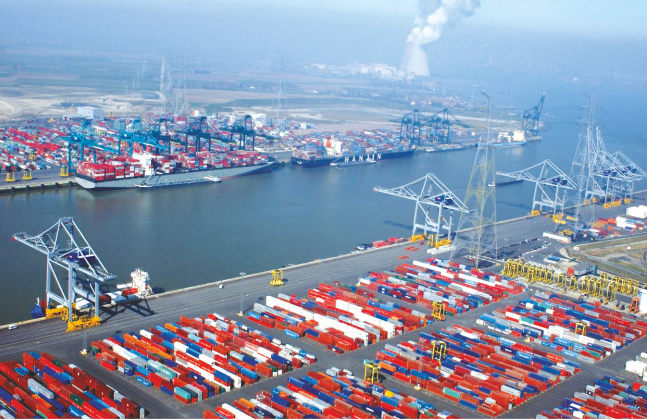[vc_row][vc_column][vc_column_text]
The pharmaceutical industry is steadily expanding its sea freight volume owing to lower fares and availability of stricter and more reliable control of temperature. The Port of Antwerp is ideally positioned to leverage on this air to ocean trend
The world is looking for cheaper drugs and India has proved it has the capability to deliver. The export of generic medicines is one of India’s strengths and in the last two years India has stepped far ahead for China. To most continents and regions where generic consumables are higher such as Latin America, the US, the Middle East and Northern African (MENA) region, Indian exports are significantly higher than its Asian counterpart’s.
In fact, India leads China in exports to the EU as well. In 2016, India’s exports were worth $1.56 billion as against China’s $1.36 billion. If India has to remain ahead of China even in the American and South East Asian and Australian regions, it would require more than the manufacturers’ effort to make the drugs available to patients across the globe. A majority of the bulk drug and active pharmaceutical industry that functions out of Hyderabad reckons that logistics – both at the port and inland play a crucial role in cutting rawmaterial supply time and export time.
While most ports such as Chennai, Jawaharlal Nehru Port Trust and Visakhapatnam Port ship exports out of India, Indian pharmaceutical firms ask for better value-added services to ensure their cargo is ready for consumption to destinations where the vials and tablets are shipped to.
Two recent developments have led the pharma sector turn to sea freight and increase the quantum of shipments moved by sea. The first factor is the increasing price pressure from among others the so-called “generics,”
making less expensive sea transport an attractive alternative. Moreover, technological advances now permit stricter and more reliable control of temperature conditions for reefer containers, enabling shipping companies to offer the same quality guarantees as airfreight operators.
Port of Antwerp, which is one of the three largest gateway ports at Europe has commenced customising services for many an industry that ship cargo to various destinations in Europe.
Therefore, from fresh fruit to pharmaceutical products that requires temperature-controlled handling, the Port of Antwerp offers an uninterrupted cold chain. In addition to discharging and loading vessels, the port offers many added value services that meet the specific requirements of every product.
With bulk of Indian pharmaceutical firms using the Port of Antwerp in Belgium to move their wares to France, Germany and other countries, the Port is customising facilities to adapt cargo closer to the needs of the selling market. Labelling, pricing and re-packaging is also undertaken for companies to ensure their products can be bought right off the shelf once they are transhipped. Luc Arnouts, Chief Commercial Officer, Antwerp Port Authority said, “Ports of tomorrow will no longer be facilitators of movement alone. They have to transform to be next generation handlers of port traffic.”
Even as ports such as Antwerp offer value-added services beyond bagging, stuffing and de-stuffing, logistics firms are extending their products and services to function as industrial logistics players to adapt to each industry’s needs. “The idea is to cut down on production postponement by respecting transit time,” said Arnouts.
Recent investments by three big logistics service providers in Antwerp underline the port’s crucial position in the worldwide pharmaceuticals industry. Together these logistics operators serve the world’s top 10 pharmaceutical companies, offering them a range of customised services.
The Antwerp warehouses act as consolidation and crossdock hubs where goods from various European production sites can be grouped for particular destinations. And vice-versa, large consignments can be broken down into smaller deliveries for different destinations within Europe. The warehouses operated by the specialist logistics service providers in Antwerp comply fully with the Good Distribution Practices (GDP) for the pharmaceutical industry, kept either refrigerated (2-8°C) or at room temperature (15-25°C).
The blisters that contain tablets, for instance, will be repackaged at Antwerp to be shipped further to France, Germany and other Nordic and Scandinavian countries.
This would save the Indian pharma company a week’s time in sending it straight to the wholesaler to retailer than the local production arm or partner who would otherwise re-pack it at a location away from the port. Customs formalities are also expertly handled at the port while the drug inspectors survey cargo before it is let out at the port. Separate warehouses for pharma products accompanied by cold chains makes the sensitive products safe from damage.
“The pharmaceutical industry is steadily expanding its sea freight volume year by year. Since our GDP warehouses are located within the port we are ideally positioned to support the air-to-ocean trend. The next step will be horizontal collaboration in which we consolidate the products for various pharmaceutical companies in a way that does not compromise quality,”
An D’hondt, head of business line Healthcare at Katoen Natie.
Steady availability of temperature controlled reefers and warehouses at ports on the European leg has made a case for ocean transport to be both safe and cost effective. If Indian logistics players work in tandem with the Port of Antwerp, sea movement of medicines to Europe could soon be a safer reality.
[/vc_column_text][/vc_column][/vc_row]








